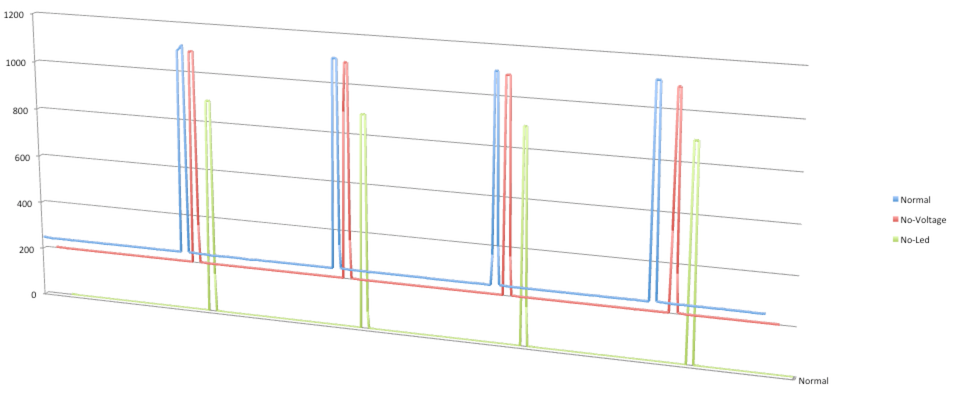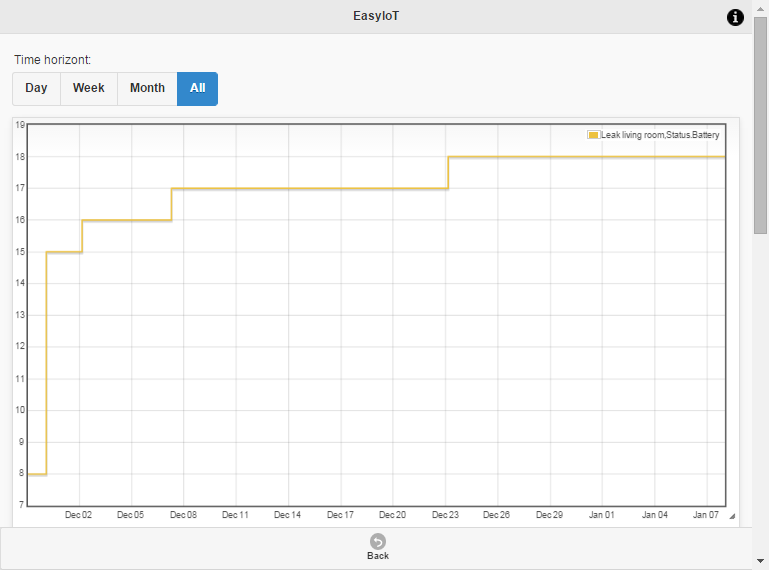Power usage with a Pro Mini as sensor node(Humidity & Temperature!)
-
I know this has been brought up before. But I thought I might as well share my expirence.
I have made 3 measurements, running the default Humidity sketch on a 16Mhz Pro Mini powered by 3.7v. Sleeping for 60 sec.

To quickly sum it up:
.................................. Sleeping........ Reading sensors(2 sec)
Normal mode : 2.48 mah......... 11.00 mah
No Power Reg: 2.07 mah......... 10.87 mah
No Reg and LED: 0.02 mah..... 8.90 mahNotice the green No-LED, Had to teste with another multimeter thats more precise, but still got around 0.02mah.
So running on a 2500mah 3.7v battery gives me 300days plus. Thats pretty good if you ask me:)/M
-
No, the 300days is purely a ballpark figure. But let's say 250-350 days with a DHT22, depending on the battery, brand, temperature ect.
The point was the 0.02mah in sleep mode. So with a good slowdrain battery thats still gives you a very decent runtime.. But of course, this only applies to usage where long sleep time is not an issue. Or even some interrupt controlled applications could keep the power usage very low.
/M
-
Very interesting, and not bad longevity at all. How much time can be bough by extending the sleep to 5 minutes? 10? I personally do not need temp/humidity sampling all that frequently.
-
What I have done in my sketch, is to wke up every 60th seconds, and take a measurement.. If the measurement differs from the last one, I send out the change. Every 30 minutes I force a transmission through.
I am using a different sensor though (Si7021) which uses ~150uA while active, and arround 0.6uA while sleeping. (according to the datasheet). I also use internal 8Mhz oscilator (I am thinking about switching to 1Mhz when I'm finished debugging, and don't need the serial port anymore).
Anyways, I have done some (theoretical) calculations on my setup.
Assumptions: I wake up every minute, and send off an measurement, lets say this take 0.5 seconds, then return to sleep mode again for the next 60 seconds
current ussage while measuring / transmitting is 15mA, and sleep mode is 0,01mA (Ballpark figures)
Iavg = (0,515+600.01)/(0,5+60)
iAvg is then ~0.13mA, if I have a 2500mAh battery, It should survive for 778 days, or a couple of years.
If I change the sleep period to 5 minutes (300 seconds) I get a lifespan of 2981 days.. However, I think that the self discharge of the batteries will influence this as well..
Anyway, for my part, I stick with transmitting every minute (if there are changes that in the measuremets)..
/ Thomas
-
It's really hard to calculate usage on a battery.
What Thomas is doing looks about right. But there is a lot of variables. So even some minor differences can tip the calculation. But again as above, 778 vs lets say ~500 days. Both are good for me.
It's more interesting if we talk 7 days vs 7 months. So in this case I am good with both calculations. As long as I get months even 1/2 years I am good.
/M
-
It's really hard to calculate usage on a battery.
What Thomas is doing looks about right. But there is a lot of variables. So even some minor differences can tip the calculation. But again as above, 778 vs lets say ~500 days. Both are good for me.
It's more interesting if we talk 7 days vs 7 months. So in this case I am good with both calculations. As long as I get months even 1/2 years I am good.
/M
-
@Magiske I've got similar results with striped Arduino pro mini at 1Mhz, HTU21D as sensor and 2 AA alkaline batteries. Sending interval is 5 min. In 46 days battery drops for 2% -> 100% in 2300 days which is 6,3 years.
@EasyIoT if you poll every hour, it will outlive Noah. (OK, maybe Shem)
-
Even if you can't do a directly 2% -> 100% calculation because of different discharge rate. Thats really good. What capacity is the battery you are using ?
Making a few for around the house. Also making one in a watertight case for outside. Only "issue" could be that lipo only are rated for -20(c) so think I will try with some nicd for the outside one.
(Living in Denmark, we properly get a MAX of 5 days below -20(c) if at all, so purly luxury problem:)
/M -
Even if you can't do a directly 2% -> 100% calculation because of different discharge rate. Thats really good. What capacity is the battery you are using ?
Making a few for around the house. Also making one in a watertight case for outside. Only "issue" could be that lipo only are rated for -20(c) so think I will try with some nicd for the outside one.
(Living in Denmark, we properly get a MAX of 5 days below -20(c) if at all, so purly luxury problem:)
/M@Magiske this is approximation. I'm using 2AA alkaline batteries. Full alkaline battery is 1,6Vx2 = 3.2V. When battery is discharged voltage at beginning drops very quickly, between 1.5V and 1V is almost linear (when discharged with low current) and then drops very quickly. At 0.8V per cell battery is practically empty.
In my case 3V and more is 100% and 2V is 0%. I've measure those 2% in linear range. So I will get more than calculated value 2300 days.I'm using wasted alkaline batteries from electric toys. Batteries are not branded. Capacity of new AA battery is between 2200 mAh and 2900 mAh. It depends on brand and discharge current. Self discharge rate of alkaline batteries is low.
Outside I'm using 50W photocell and Pb accumulator. It works in the winter (min -15C couple of days). This is also power supply for balcony irrigation system.
Total winner in low power consumption is my water leak sensor. Power consumption is so low, that after I put wasted battery in sensor from LCD temperature display voltage actually raise after couple of days.
Battery status:
1.dec 8%,
8,jan 18%.

-
Even if you can't do a directly 2% -> 100% calculation because of different discharge rate. Thats really good. What capacity is the battery you are using ?
Making a few for around the house. Also making one in a watertight case for outside. Only "issue" could be that lipo only are rated for -20(c) so think I will try with some nicd for the outside one.
(Living in Denmark, we properly get a MAX of 5 days below -20(c) if at all, so purly luxury problem:)
/M@Magiske said:
Making a few for around the house. Also making one in a watertight case for outside. Only "issue" could be that lipo only are rated for -20(c) so think I will try with some nicd for the outside one.
If you are going to make that watertight, wouldn't it make it impossible to measure the humidity in the air outside the box? ;)
